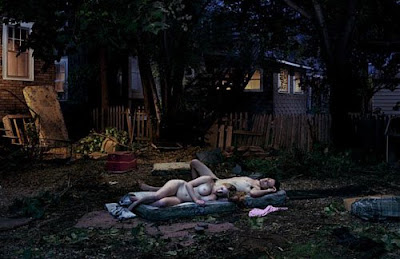Wednesday, April 15, 2009
At the interesection of EVENT and MEMORY... a stange attractor
I recently ran across a new(ish) collection of Gregory Crewdson photos. I have long admired his work, but was particularly moved by some of these new images. (samples above). Text threads are my own thoughts.
Crewdson says of his own work in an interview with SITE:
"...although the work is influenced by film, I'm very struck by the still image, and I'm interested in the limitations of a photograph in terms of its narrative capacity to have an image that's frozen in time, and there's no before or after."
and this from an interview with npr:
"The images, he says, come to him while swimming. He teaches at Yale University, and has a studio in New York; in the city, he swims in a pool. But Crewdson says he prefers to swim outside, in lakes and rivers. The world beyond the shore, he says, offers very little time for imagination, to get lost in unconscious thoughts -- he finds that time in the water."
Another description from Whitecube:
"Gregory Crewdson works within a photographic tradition that combines the documentary style of William Eggleston and Walker Evans with the dream-like vision of filmmakers such as Stephen Spielberg and David Lynch. Crewdson’s method is equally filmic, building elaborate sets to take pictures of extraordinary detail and narrative portent. When he was ten, Crewdson’s father, a psychoanalyst, took him to see a Diane Arbus exhibition at MoMA, an early aesthetic experience that informed his decision to become a photographer. Work includes the Natural Wonder series, dioramas created by the artist with insects, animals and body parts in small-town settings both mundane and menacing. Recent series include Twilight and Beneath the Roses, everyday scenes with charged, surreal moods that hint at the longings and malaise of suburban America. These pictures are like incomplete sentences, with little reference to prior events or what may follow. The artist has referred the 'limitations of a photograph in terms of narrative capacity to have an image that is frozen in time, (where) there's no before or after' and has turned that restriction into a unique strength."
Subscribe to:
Post Comments (Atom)











No comments:
Post a Comment